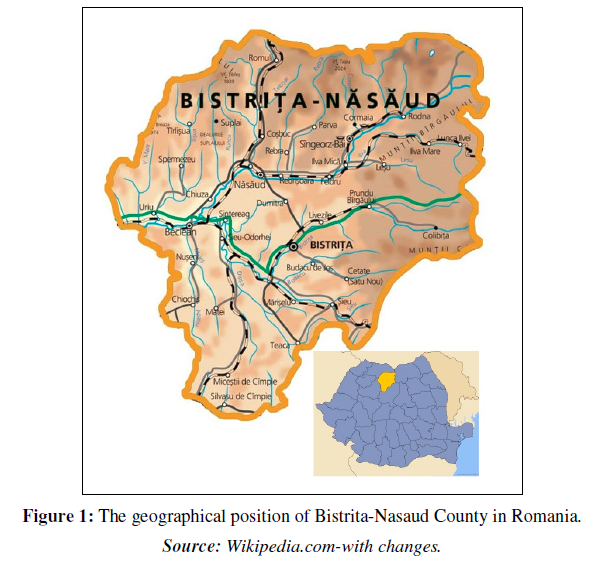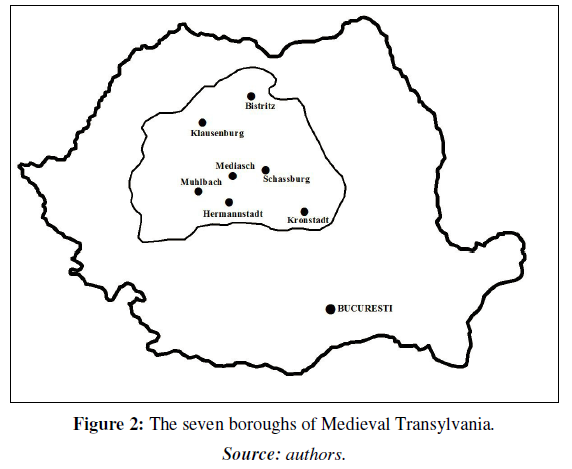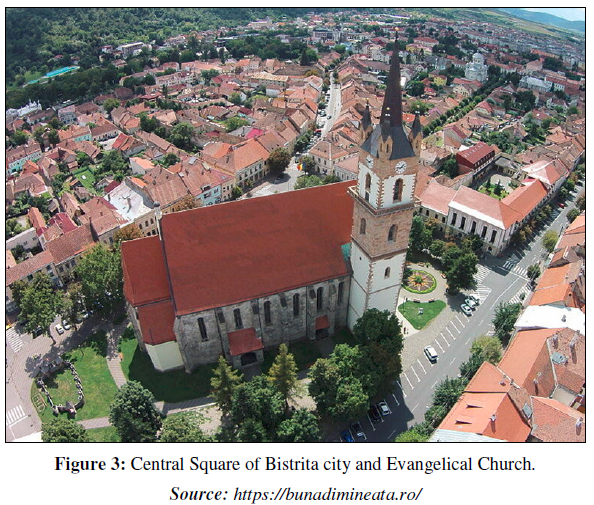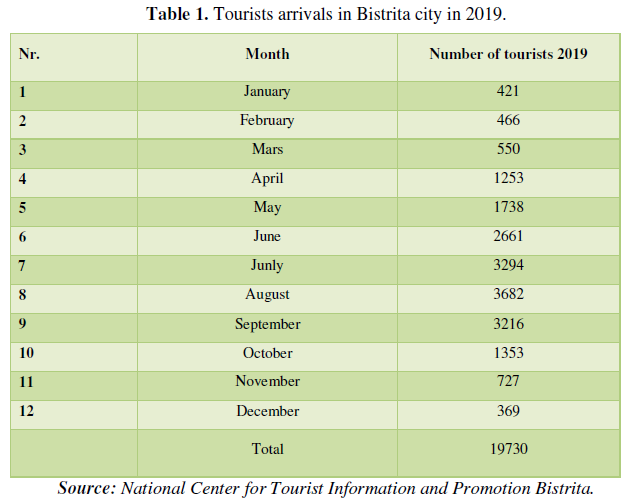Research Article
THE ROLE OF MYTHS, LEGENDS, AND STORIES IN TOURISM. CASE STUDY: BISTRITA CITY (ROMANIA)-DESTINATION FOR SPIRITUAL TOURISM
31527
Views & Citations30527
Likes & Shares
ABSTRACT
Myths, legends and stories that accompany cultural-historical tourist attractions are distinguished by several functions, such as: attract tourists to a particular destination, impress visitors and offer unique experiences, are key elements in defining a tourist destination, arouse the curiosity and interest of tourists, increase the value of attraction and destination, amplify the attractive potential, stimulate creativity, generate mystery, fear, admiration and ecstasy, outline the tourist image of the destination, promote local history and culture, motivate and mobilize tourists. Attractions that have myths, legends or stories with attractive value are represented by geographical places, buildings, statues, caves, lakes, forests or landforms (rocks, mountains, peaks), and the target audience that consumes the spiritual load of these tourist destinations it is represented by people eager for knowledge, exploration and adventure, who believe, feed and broaden their cultural horizon with the intangible cultural heritage. In this context, this paper aims to analyze the myths, legends and stories that accompany certain cultural and historical attractions in the city of Bistrita, located in Bistrita-Nasaud County (Romania).
Keywords: cultural-historical tourism, Transylvania, intangible cultural heritage, cultural events, cultural identity
INTRODUCTION
The city of Bistrița is located in the central-eastern part of Bistrița-Năsăud County, in the historical region of Transylvania, and was founded by the Saxon settlers at the beginning of the 13th century (Figure 1). The first documentary attestations of the city date from 1241 (under the name of Nosa) and from the year 1264 (under the name of Bistrita), this being, at that time, one of the seven boroughs (Siebenburgen) of Transylvania, next to Brașov (Kronstadt), Cluj (Klausenburg), Mediaș (Mediasch), Sebeș (Muhlbac), Sibiu (Hermannstadt), and Sighișoara (Schassburg) (Figure 2). From a geostrategic point of view, the city of Bistrița was founded as a fortress for the defense of the road that connects Transylvania with Bucovina, on the Bargau Valley, through the Tihuţa Pass, and becomes the center of the land that will be called the Saxon District of Bistrița.
The urban core of the medieval city was structured around the Central Square (Marktplatz), dominated by the parish church, and its eastern and western boundaries are given by the three monastic settlements built by Franciscans, Dominicans and Hospitallers in the late thirteenth century (Figure 3).






Along with these religious buildings, houses, schools, hospitals and pharmacies were built in the city, some of which are still preserved today (eg. the Sugalete Ensemble, Andreas Beuchel House, Silversmith House). In the 15th century, based on a royal privilege given by King Matthew Corvin, the city was surrounded by walls, marked by gates (Wood Gate, Frog Gate, Hungarian Gate, Hospital Gate) and defense towers, guarded by guilds (Tailors 'Tower, Blacksmiths' Tower, Carpenters 'Tower, Saddlers' Tower, Goldsmiths 'Tower, Butchers' Tower, Funerals 'Tower, Rotarians' Tower, Masons 'Tower, Curlers' Tower). In the second half of the 19th century, most of the wall surrounding the city was demolished, with a few fragments of it and the Carpenter's Tower preserved today. In the XVIII-XIX centuries and at the beginning of the XX century, the architectural legacy of the city is enriched with a series of buildings in baroque and neoclassical style, among which we can mention the Palace of Culture, Liviu Rebreanu National College, Andrei Mureșanu National College etc. (Rădulescu, 2004; Gaiu, Duda, 2008; Bîca, Onofreiu, 2014; Duda et al., 2017). During the communist years, the city expanded and realist-socialist constructions were added, represented by institutions, commercial units, blocks of flats, etc.
In this historical and cultural context, the city of Bistrita is a inhabited medieval fortress, and has stood out on the tourist market in Romania as a destination for cultural and event tourism, where many festivals take place, such as: Medieval Bistrita Celebrations, International Folklore Festival Zamfira's Wedding, Bistrita's Big Fair, Oktoberfest, Pfingstfest, Gypsy Traditions Festival, Liviu Rebreanu International Theater and Literature Festival, etc.
In 2011, Bistriţa City Hall launched the tourist product “Medieval Fortress Bistriţa”, on which occasion the identity elements of this product were created, namely the logo (the stylized Evangelical Church and Sugalete Ensemble) and the slogan (Bistrița-Transylvania Gate).
In addition, to the well-known cultural and historical resources of the city, which addresses a certain segment of tourists, a solution to expand the tourist market and attract a new generation of tourists would be to capitalize on the myths, legends and stories that accompany certain objectives.
Therefore, this study aims to analyze these myths and highlight their spiritual side so that they become cultural tourist attractions integrated into various strategies for tourism promotion of the city of Bistrita.
MATERIALS AND METHODES
For the elaboration of this article, the following methodological steps were followed:
-Consultation of specialized works (history, art, mythology) related to the city of Bistrita and Transylvania (Muller, 1857; Ionașcu, 1938; Radulescu, 2004; Wortisch, 2013; Bîca, Onofreiu, 2014; Duda, Gaiu, Klein, 2015, 2017, 2018);
-Consulting works related to the analysis of myths in the culture of peoples (Barthes, 1972; Eliade, 1978; Brunel, 1988; Eliade, 1991; Angelescu, 1999);
-Consulting articles related to the role of myths in tourism (Rougemont, 2000; Prus, 2004; Morgan et al., 2010; Verbeke-Myriam, 2010; Prideaux et al., 2012; Korstanje, George, 2015; Pérez-Aranda et.al., 2015; Peng, 2017; Nilsson, Blom, 2018);
-Classification of myths, legends and stories and their adaptation for tourism.
LITERATURE REVIEW
According to the Explanatory Dictionary of the Romanian Language, online version:
1) The story/tale/fairy tale is a kind of (popular) epic in prose, in which fantastic events of imaginary characters are told, in battle with bad characters;
2) The narration/story is the exposition or narration in literary form of a fact, an event, etc., specific to the epic genre;
3) The myth represents a fabulous story with a sacred character that includes the beliefs of a people about the origin of the Universe and the phenomena of nature, about legendary gods and heroes, etc;
4) The legend is a species of popular epic, in prose or verse, which contains fantastic or miraculous elements, which explain the genesis of a thing, a being, the special character of a historical event, a mythical hero or a phenomenon.
The problem of myths, legends and stories is found in numerous analytical works (Angelescu, 1999; Barthes, 1972; Brunel, 1988; Eliade, 1978; Eliade, 1991; Prus, 2004; Rougemont, 2000), but also in studies for tourism (Ionașcu, 1938; Korstanje, George, 2015; Morgan, Lugosi, Titchie Brent, 2010; Muller, 1857; Nilsson, Blom, 2018; Prahase, 2000; Peng, 2017; Pérez-Aranda, Guerreiro, Mendes, 2015; Prideaux, Cave, Sibtain, 2012; Wortisch, 2013), because these literary species of fiction fulfill several attractive functions, as follows: arouse curiosity and interest, increase the value of attraction and tourist destination, amplify the attractive potential, stimulate the imagination and creativity of organizers and tourists , generates mystery, fear, admiration and ecstasy, outlines the tourist image of the destination, promotes local history and culture, motivates and mobilizes tourists.
Myth, as (Eliade says,1978), is an extremely complex cultural reality that can be approached and interpreted in multiple and complementary perspectives. Knowing and understanding the myth brings us closer to the origin of things and, thus, we have the opportunity to relive the events that generated it. For the tourist this is a very important thing, because it makes him part of a unique experience, and the image of the tourist destination receives new attractive dimensions. According to Barthes (1972, 107) myth is a type of discourse, a system of communication or a message, and the most important part is how this message is transmitted. In tourism, the transmission of the message belongs to the organizations that manage and promote the tourist attractions, as well as to the guides. They, through appropriate methods and techniques, can create the psychological framework through which tourists are transposed in the midst of mythical events. All the more, so as the collective mentality and psyche, which has accumulated dreams and hopes, is waiting for the opportunity to identify with phenomena and characters that have supernatural powers (Prus, 2004).
Myths and legends are fantastic stories about characters and facts, about timeless eras and dimensionless events. They describe an alternative reality, to which the community adheres, because they evoke a realm unattainable for the human being, a realm where everything is possible, a realm shaped by the human mind, defined by expressions such as: once upon a time, it is said that, at that time etc. Myths, legends and stories can be the basis of brands and the tourist image that a destination can have, and for this there are myths built by agencies, companies, literary works, media, inhabitants, etc., which represent a social construction. (Peng, 2017).
In tourism, the myths, legends and stories that accompany the cultural-historical attractions fulfill several functions, such as: they attract tourists to a certain destination, impress visitors and offer them unique experiences, are key elements in defining a tourist destination, arouse curiosity and the interest of tourists, increase the value of attraction and destination, amplify the attractive potential, stimulate creativity, generate mystery, fear, admiration and ecstasy, shape the tourist image of the destination, promote local history and culture, motivate and mobilize tourists.
Regarding the value of the attraction and the perception of tourists, we must consider the following components:
-primary, material value of the attraction, given by its intrinsic characteristics (antiquity, significance, architectural style, etc.);
-secondary, spiritual value of the attraction, given by the mythical or legendary aura that surrounds it;
The target audience that consumes the spiritual load of tourist destinations is represented by people eager for knowledge, exploration and adventure, who believe, feed and expand their cultural horizon with myths, legends and stories. Attractions that have myths, legends or stories are represented by geographical places, buildings, statues, caves, lakes, forests or landforms (rocks, mountains, peaks).
RESULTS AND DISCUSSIONS
Myths, legends and stories that accompany the cultural-historical attractions of Bistrita are included in certain specialized works (Duda, Gaiu, Klein, 2015; Duda, Gaiu, Klein, 2017; Duda, Gaiu, Klein, Toma, 2018; Ionașcu, 1938; Wortisch, 2013).
As part of the intangible cultural heritage, they are potential resources for spiritual tourism, which, unfortunately, is not promoted in the city, although Transylvania is a tourist destination for hunters of legends and historical stories. Here are some of the attractive goals of myths, legends and stories:
The Knight's Slab
-it is located on the southern wall of the Evangelical Church, it is dated 1327, and on it is represented a knight with long hair, sword and shield;
-legend 1: the knight on the slab is Paltaleo Circuli, who lived in Bistrita in the 14th century, and contributed to the consolidation of the urban community;
-legend 2: the knight on the slab was the messenger of the king of Hungary, sent to Bistrita, who died of typhus;
-legend 3: the character on the slab is a beautiful and very rich woman, named Ursula, who made many donations to the churches in Bistrita and helped the poor;
Andreas Beuchel House/Ioan Zidarul House (Johannis Murator)
-it is located in the Central Square;
-the building is a house with floor and balcony in Gothic style;
-legend 1: the house belonged to the citizen Andreas Beuchel, who became the county (mayor) of the city between 1525-1526; during a siege exercised by the Moldovian army, he took refuge in Suceava, where he asked for help from Prince Petru Rareș in order to restore the county; the ruler makes peace with the city's representatives and hands Andreas Beuchel over to them, who accuses him of treason and executes him in the city's Central Square (Marktplatz), in 1531; to be a good example for possible traitors, his face was represented in stone, at the top of the wall of the evangelical church, facing his house, suggesting that he would like to say: who makes him, let him suffer!;
-legend 2: Andreas Beuchel's house was bought by a well-known bricklayer named Ioan, after he took refuge in Moldova, where he was to be tried by the ruler of Moldova, Petru Rareș, for a construction error at St. Demeter Church in Suceava;
The statue of the blacksmith Georg Pfaffenbruder
Georg Pfaffenbruder was a blacksmith of the city, who stands out in the battle between the army of General Basta and the people of Bistrita, in February, 1602; he, after breaking his halberd in battle, hastily seizes a sledgehammer from his workshop and enters the battle with him, making many casualties; in the end, he conquers the imperial banner, breaks it and throws it to the ground; General Basta gives up the assault and is forced to conclude an armistice with the people of Bistrita;
The tower of the Evangelical Church
-It is the tallest tower in Transylvania (75 m);
-It was built at the beginning of the 16th century (1519);
-Legend 1: hearing the Saxons from Sibiu that in Bistriţa there would be the tallest church tower, they sent spies to measure it, so that they could build a bigger tower; after measuring, the Sibiu craftsman, they went to an inn and, with a glass of wine, word for word, revealed the purpose of the trip; then, the people from Bistrita present, in order to ruin their plans, shortened by about 2 meters the rope with which they had measured the height of the tower; this is how the Tower of the Evangelical Church in Sibiu is around 73 meters long, and the one in Bistrita is still the tallest tower in Transylvania, with 75 meters;
-Legend 2: the stones of the tower were raised on an earth ramp, which reached the end of Hospital Street;
-Legend 3: the night watchman of the church would have sat on the railing of the terrace that surrounds the tower, at an appreciable height, so as not to fall asleep; although the fear of not falling should have kept him awake, he fell asleep one night and fell from a height of 60 m to never get up again;
-Legend 3: a tailor bet that he can sew a trouser leg sitting on the terrace railing; he sat down on the railing, lowered his legs, and began to work; towards the end, when there were a few more stitches to be made, the tailor's spool fell with a thread, at which point he hurried to catch it, but lost his balance and collapsed (Wortisch, 2013).
Textoris House
-It is located on Gheorghe Șincai Street;
-The legend: the house was built in 1864, by the Lutheran priest Textoris from Orhei of Bistrita, with the funds resulting from the sale of gold and jewels found in a marble ball that broke; this ball was brought to the parish priest, who used it as a paper press on the desk; one day, the ball rolled, fell and broke, spilling gold and gems;
he cave on Burgh Hill:
-It is carved in conglomerates and is located in the southern part of the ridge of Burgh Hill (680 m), in the forest;
-The legend: the cave represents the exit from the tunnel that the Saxons would have dug in the medieval period, to take refuge in the fortress on the hill, in case of a siege; the entrance to the tunnel would have been in the Evangelical Church;
Liviu Rebreanu pedestrian street
-It is located in the old town and owns a building, which in the 19th century housed the King of Hungary Hotel;
-The myth: it is said that the writer Bram Stoker would have taken this hotel as a model for the Golden Crown hotel from his novel Dracula;
Golden Crown Hotel
-Named after the fictional hotel in the novel Dracula, written by Bram Stoker and owns a salon called Jonathan Harker, after the main character, who spends the night here before leaving for the castle of Count Dracula in the Carpathians;
Minorities Church:
-It is the oldest church in the city, built in the 13th century by the order of the minorities monks;
-The legend: during the renovation works in 2019, a room was discovered above the shrine in which it is said that the treasurer of voivode Mihai Viteazul (Michael the Brave) was imprisoned.
-The most important myth that put the city of Bistrita on the map of spiritual and literary tourism is the one generated by the novel Dracula, written by Bram Stoker. The novel was launched in 1897 and enjoyed enormous success, generating Dracula tourism in the twentieth century (Florescu, McNally, 1972, 1994; Florescu, Cazacu, 2013). In this novel, there are two places of interest for Bistrița-Năsăud County:
-The city of Bistrita, where the lawyer Jonathan Harker, on his way to the castle of Count Dracula, from the Carpathians, spends the night at the Golden Crown Hotel;
-The Borgo Pass, where the lawyer Jonathan Harker is taken over by Count Dracula's carriage, to be taken to the castle.
Therefore, in the 70s and 80s of the twentieth century, the Ministry of Tourism and the county authorities decided to capitalize on this myth through two important projects:
-The construction in Bistrița, in 1974, of a hotel called the Golden Crown, in which the Jonathan Harker salon was arranged, after the name of the main character in the novel;
-The construction in Borgo Pass, in 1983, of a castle-hotel, called Dracula.
In this context, Bistrița has become an important destination for Dracula tourism, along with the cities of Brașov, Bran and Sighișoara, being frequently included in the tourist circuits in Transylvania.
Regarding the capitalization of the other myths and legends analyzed in this article, in 2020 the Bistrița-Năsăud County Council launched the county's tourism brand, called Bistrița-Năsăud The Gate of Transylvania, and one of the priorities of this project is to transform the city into a destination for spiritual tourism. Therefore, more actions will be launched in the next period, such as:
-Signalization of artifacts bearing mythical connotations;
-The installation of plaques on which to be inscribed the respective myths, legends and stories;
-Arranging a route of myths, legends and stories that would include all locations with spiritual connotations (Ioan Zidarul House, Evangelical Church, Burgh Hill);
-Publishing brochures and guides book with the myths, legends and stories of the city.
According to the data provided by the National Center for Tourist Information and Promotion in Bistrita (Table 1).19,730 visitors arrived in Bistrita in 2019, of which 7892 were foreigners, most of them from Germany, Hungary, France and Austria, with whom Italy, Spain, Greece, Serbia, Ukraine, USA, Japan, Mexico, Brazil, Venezuela, Argentina, China, India and South Korea can be mentioned. They were interested in the old town, the cultural events here and the tourist destinations in the vicinity, Colibita, Piatra Fântânele, Băile Figa and Alpina Blazna. In this context, the promotion of legends and stories that accompany the attractive sights of the old town would increase the interest of visitors and expand the market of cultural-historical and spiritual tourism.


As part of the intangible cultural heritage, the legends and stories of Bistrita could contribute to its development through: infrastructure innovations, promoting the city's image, relaunching traditional cultural activities and connecting the city to the Vienna-Budapest-Oradea-Cluj-Napoca cultural axis, contributing thus promoting the European cultural identity (Verbeke, 2010). The actors involved in this project must be primarily: Bistrița-Năsăud County Council, Bistrița City Hall, Bistrița National Center for Tourism Promotion and Information, Bistrița-Năsăud Museum Complex and Bistrița-Năsăud County Directorate for Culture, Cults and National Heritage.
CONCLUSIONS
The myths, legends and stories analyzed can market the city of Bistrita, as a destination for cultural-spiritual tourism, opening to a new tourist market and another segment of the public.
The myths, legends and stories that accompany certain attractive architectural objectives in the city of Bistrita are based on:
-Real artifacts: Ioan Zidarul House, Evangelical Church, the building of the former King of Hungary Hotel, the Golden Crown Hotel, the ruins of the fortress on Burgh Hill, the Minorities Church;
-Real characters: Ursula Paulin, the judge Andreas Beuchel, the master builder Ioan Zidarul, the blacksmith Georg Pfaffbruder;
-Supposed real characters: the knight Paltaleo Circuli, the Saxon craftsmen from Sibiu, the night guard of the evangelical church, the tailor of the city, the treasurer of the voivode Mihai Viteazul (Michael the Brave);
-Fictitious characters: lawyer Jonathan Harker;
-Real events: the execution of Andrea Beuchel, the purchase of Andreas Beuchel's house by the master Ion Zidarul, the construction of the tower of the Evangelical Church, the siege of Bistrița by General Basta, the fortress on Burgh Hill;
-Presumed events: the contribution of the knight Paltaleo Circuli to the well-being of the city, the measurement of the height of the Evangelical Church tower by the Saxon craftsmen from Sibiu, the construction of a tunnel between the Evangelical Church and the fortress on Burgh Hill, the tailor's bet that he can sew a pair of trousers sitting on the railing of the tower, the incarceration of the treasurer of the voivode Mihai Viteazul (Michael the Brave) in the secret room of the Minorities Church;
-Fictitious events: the night of the lawyer Jonathan Harker, from the novel Dracula, at the Golden Crown Hotel.
Declaration of Conflicting Interests
The authors declared no potential conflicts of interest with respect to the research, authorship, and/or publication of this article.
Funding
The author disclosed receipt of the following financial support for the research, authorship, and/or publication of this article: This work was supported by the Babes-Bolyai University, Faculty of Geography.
- Angelescu, S. (1999). Mitul şi literature Bucureşti Ed Univers.
- Barthes, R. (1972). Mythologies New York Farrar Straus&Giroux.
- Bîca, I., & Onofreiu, A., (2014). Bistrița 750. Coordonate geografice și istorice Ed. Argonaut ClujNapoca.
- Brunel, P. (1988). Dictionnaire des mythes littéraires Paris Editions du Rocher.
- Duda, V., Gaiu, C., & Klein, G. (2015). Cultură și civilizație la Bistrița carte pentru ciclul gimnazial Bistrița
- Duda, V., Gaiu, C., & Klein, G. (2017). Cultură și civilizație la Bistrița carte pentru ciclul liceal Bistrița.
- Duda, V., Gaiu, C., Klein, G. Toma, & Nicoleta, (2018). Cultură și civilizație la Bistrița carte pentru ciclul primar Bistrița
- Eliade, M., (1978). Aspecte ale mitului Ed Univer București.
- Eliade, M., (1991). Eseuri Mitul eternei reîntoarceri. Mituri vise şi mistere Bucureşti Editura Ştiinţifică.
- Florescu, R., & McNally, R.T., (1972). In Search of Dracula the History of Dracula and Vampires Little Brown Boston.
- Florescu, R., & McNally, R.T., (1994). In search of Dracula the history of Dracula and vampires Houghton Mifflin Co.
- Florescu, R., & Cazacu, M. (2013). Draculas Bloodline A Florescu Family Saga Kindle
- Ionașcu, I. (1938). Relatări şi tradiţii istorice de pe Valea Budacului Arhiva Someșană. 219-223
- Korstanje, M.E., & George, B.P. (2015). The media or the message? An examination of myths as resources to understand the tourism phenomenon, Int. J. Tourism Anthropology 4,(2).
- Morgan, M., Lugosi, P., & Titchie Brent, J.R. (2010). The Tourism and Leisure Experience: Consumer and Managerial Perspectives Channel View Publications MPG Grup Ltd UK, 43-58
- Muller, Fr. (1857). Legende Transilvănene, Brașov
- Nilsson, M., & Blom, Th., (2018). Finisterre: being and becoming a myth-related tourist destination Leisure Studies, 37:4, 359-370. Routlege Taylor & Francis Group
- Peng, D. (2017). Tourism myth-making a case study of ancient city of Fenghuang in western Hunan Province Tourism Tribune 32(9), 34-46.
- PérezAranda, J.R., Guerreiro, M., & Mendes, J. (2015).Are myths and legends used in toruism communication as a resource. The case of Algarve Online Brochures Enlightening Tourism. A Pathmaking Journal 5(1), 65-99.
- Prideaux, B., Cave, Jenny, Thomson, Michelle, et al., (2012). Recognizing new markets opportunities and selecting appropriate segments Targeting Chinese outbound tourists. Journal of Vacation Marketing 18, 287
- Prus, & Elena, (2004). Poetica mitului Revista Limba Română Nr4-6 anul XIV
- Radulescu, G., (2004). Bistrița o istorie urbană Ed Limes Cluj Napoca
- Rougemont, D., (2000). Iubirea şi Occidentul Bucureşti Univers.
- Verbeke Myriam Jansen, (2010). Transformation from historic cityscapes to urban tourismscapes a discussion notes Revista di Scienze del Turismo 2.
- Wortisch, Th. (2013). Biserica Evanghelică din Bistrița ClujNapoca.





